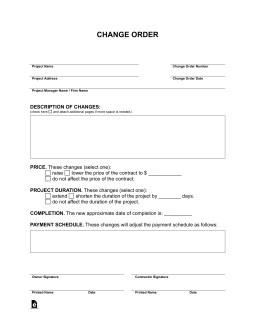Updated March 09, 2024
A change order is a document where a client and a contractor agree to make changes to their original contract for a construction project. After both parties sign a change order, it should be attached and made part of the original agreement.
Commonly Includes
- Project Details
- Change Order Details
- Price (Existing and New)
Table of Contents |
What Should be Included (6 items)
1. Description of Changes
This should be a clear and detailed description of the change(s) to be made. Changes must be within the scope of the original contract.
2. Identify the Parties Involved
Include the names and addresses of the individuals that are making the changes. For simple changes, this will be just the owner and contractor. For forms needing an architect’s signature, use American Institute of Architects Form G701.
3. Changes in Final Cost
Changes to the scope of work will likely result in a change to the final cost of the project. Include the dollar amount by which the price is being raised or lowered and the updated price.
4. Change of Completion Date
Depending on the change(s) that are being made, the estimated date of completion will change. Include the number of days that the completion date is being changed and the new completion date.
5. Changes to the Payment Schedule
If the payment schedule defined in the original contract will be impacted by the changes, then a new payment schedule will need to be detailed in the change order.
6. Signatures
Each party will sign the change order as their acknowledgment of the changes that will take place.
When to Use
Whenever elements of the original contract need to be adjusted, a change order is used to make the necessary revisions. Change orders can be used for:
- Change in Scope: If the owner/contractor decides to adjust any project elements, a change order documents the changes and communicates them to other parties.
- Change in Schedule: If a project’s timeline is delayed or accelerated for any reason, a change order is used to update the schedule and adjust the project’s cost.
- Change in Materials: When changes to the materials specified in the original contract are made, a change order specifies new materials and adjusts the cost.
- Change in Site Condition: If unforeseen conditions or circumstances arise, a change order documents the corrective action to be taken.
- Change in Regulations or Codes: If changes to regulations, zoning laws, or building codes affect the project, a change order records necessary revisions.
Limitations
There are limitations to what can be accomplished using change orders, and varying rules for change orders and form inclusions can be found at respective state departments of labor. Courts typically do not allow them to be used to:
- exceed the scope of the original project, or
- to defeat the purpose of the original contract.
These limitations are in place for good reason. For example, if a contractor is hired to install a swimming pool, change orders may not be used to force the contractor to build a barn in addition to (or instead of) the swimming pool.
How to Use (5 steps)
- A Need for Change is Identified
- Contractor Writes a Proposal
- Proposal is Negotiated
- A Change Order is Prepared
- Change Order is Signed
In a residential construction project, the change process begins when one party (usually the homeowner or a contractor) identifies the need for a change and brings it to the other parties’ attention. The process will typically proceed as follows.
Sample
CHANGE ORDER
Project Name: [PROJECT NAME] Change Order Number: [CHANGE ORDER #]
Project Address: [PROJECT ADDRESS] Change Order Date: [CHANGE ORDER DATE]
Project Manager Name / Firm Name: [PROJECT MANAGER NAME / FIRM NAME]
DESCRIPTION OF CHANGES:
(check here ☐ and attach additional pages if more space is needed.)
[DESCRIPTION OF CHANGES]
PRICE. These changes (select one):
☐ raise ☐ lower the price of the contract to $[NEW CONTRACT PRICE]
☐ do not affect the price of the contract.
PROJECT DURATION. These changes (select one):
☐ extend ☐ shorten the duration of the project by [# DAYS] days.
☐ do not affect the duration of the project.
COMPLETION. The new approximate date of completion is: [COMPLETION DATE]
PAYMENT SCHEDULE. These changes will adjust the payment schedule as follows:
[PAYMENT SCHEDULE CHANGES]
____________________________ ____________________________
Owner Signature Contractor Signature
____________________________ ____________________________
Printed Name Date Printed Name Date


